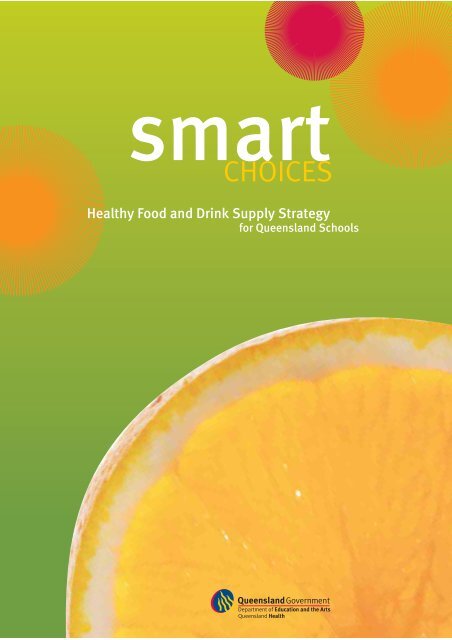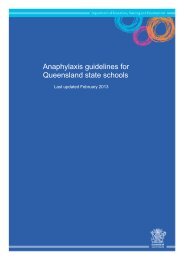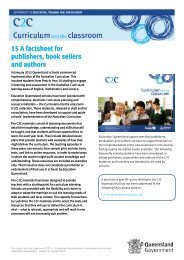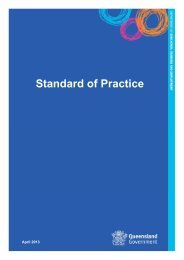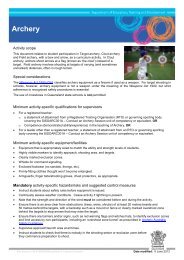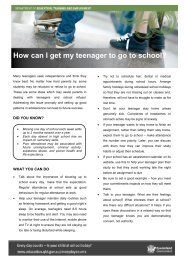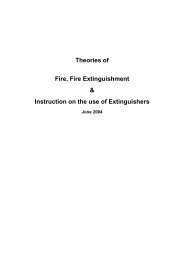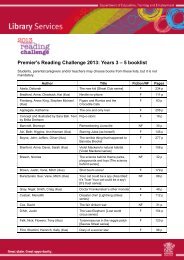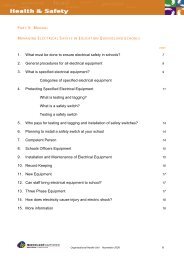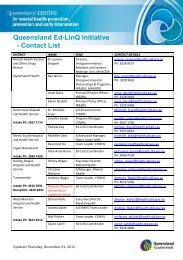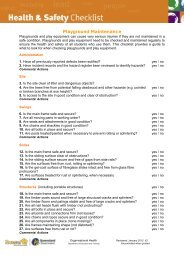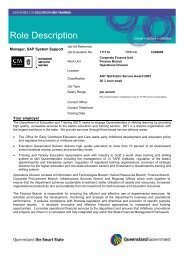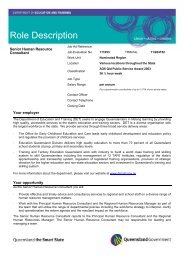Smart Choices - Healthy Food and Drink Supply Strategy for ...
Smart Choices - Healthy Food and Drink Supply Strategy for ...
Smart Choices - Healthy Food and Drink Supply Strategy for ...
Create successful ePaper yourself
Turn your PDF publications into a flip-book with our unique Google optimized e-Paper software.
smart<br />
CHOICES<br />
<strong>Healthy</strong> <strong>Food</strong> <strong>and</strong> <strong>Drink</strong> <strong>Supply</strong> <strong>Strategy</strong><br />
<strong>for</strong> Queensl<strong>and</strong> Schools<br />
Queensl<strong>and</strong> Health
Acknowledgments<br />
The Queensl<strong>and</strong> Health <strong>and</strong> Education Queensl<strong>and</strong> Joint Work Plan<br />
2004–2007 <strong>Healthy</strong> Weight Working Group has produced a strategy to<br />
address the nutritional value of food <strong>and</strong> drinks supplied in Queensl<strong>and</strong><br />
schools.<br />
The strategy is based on the NSW Department of Health <strong>and</strong> NSW<br />
Department of Education <strong>and</strong> Training Canteen Menu Planning Guide,<br />
2004, which is part of the NSW <strong>Healthy</strong> School Canteen <strong>Strategy</strong>.<br />
Education Queensl<strong>and</strong> <strong>and</strong> Queensl<strong>and</strong> Health wish to thank <strong>and</strong><br />
acknowledge the contribution of the following people in the development<br />
of the <strong>Healthy</strong> <strong>Food</strong> <strong>and</strong> <strong>Drink</strong> <strong>Supply</strong> <strong>Strategy</strong> <strong>for</strong> Queensl<strong>and</strong> Schools.<br />
Working Group<br />
Ms Jacky Dawson, Education Queensl<strong>and</strong> (Chair)<br />
Mr Mathew Dick, Queensl<strong>and</strong> Health (Secretariat)<br />
Mr Tony Kitchen, Queensl<strong>and</strong> Catholic Education Commission<br />
Dr Am<strong>and</strong>a Lee, Queensl<strong>and</strong> Health<br />
Ms Jenene Rosser, Association of Independent Schools Queensl<strong>and</strong><br />
Mr Ian Whitehead, Sport <strong>and</strong> Recreation Queensl<strong>and</strong><br />
Nutrition Reference Group<br />
Australian Dental Association Queensl<strong>and</strong><br />
Australian Medical Association Queensl<strong>and</strong><br />
Diabetes Australia Qld<br />
Dietitians Association of Australia, Queensl<strong>and</strong> Division<br />
Education Queensl<strong>and</strong><br />
Federation of Canteens in Schools (FOCiS)<br />
Federation of Parents <strong>and</strong> Friends Associations<br />
Health Promoting Schools Association Queensl<strong>and</strong><br />
Heart Foundation (Queensl<strong>and</strong> Branch)<br />
Home Economics Institute of Australia (Queensl<strong>and</strong>) Inc.<br />
Nutrition Australia<br />
Queensl<strong>and</strong> Association of School Tuckshops<br />
Queensl<strong>and</strong> Council of Parents <strong>and</strong> Citizens’ Associations Inc.<br />
Queensl<strong>and</strong> Health (Chair)<br />
School Nutrition Action Coalition<br />
The Queensl<strong>and</strong> Independent Schools Parents Council<br />
Copyright protects this publication. Except <strong>for</strong> purposes permitted by<br />
the Copyright Act, reproduction by whatever means is prohibited.<br />
Queensl<strong>and</strong> schools are permitted to make multiple copies of the material<br />
in this book without infringing copyright, provided the number of copies<br />
does not exceed the number of copies required in any one school. Any<br />
inquiries should be addressed to the Copyright Officer, Education<br />
Queensl<strong>and</strong>, PO Box 15033, City East, Qld 4002.<br />
ISBN 0734 519 761<br />
050091
Contents<br />
<strong>Smart</strong> <strong>Choices</strong> 2<br />
Background 3<br />
<strong>Smart</strong> <strong>Choices</strong> <strong>Food</strong> <strong>and</strong> <strong>Drink</strong> Selector 7<br />
Nutrient criteria to identify ‘Occasional’ foods <strong>and</strong> drinks 14<br />
Reading nutrition in<strong>for</strong>mation panels 16<br />
Nutrition in<strong>for</strong>mation <strong>and</strong> serve size 17<br />
Ready Reckoner 19<br />
Resources 24<br />
How to use the CD-ROM 26<br />
1
<strong>Smart</strong> <strong>Choices</strong><br />
In recent years, levels of overweight <strong>and</strong><br />
obesity in children <strong>and</strong> young people have<br />
increased dramatically – now around a quarter<br />
of our children are overweight or obese. This is<br />
a serious issue as overweight <strong>and</strong> obesity carry<br />
a greater risk of a number of immediate <strong>and</strong><br />
long-term health <strong>and</strong> psychosocial problems.<br />
Excess weight gain in children is usually a<br />
result of excess energy intake (kilojoules or<br />
calories) through eating too much food or the<br />
wrong type of food, combined with doing too<br />
little physical activity or being inactive <strong>for</strong> too<br />
much of the day. <strong>Food</strong> <strong>and</strong> drinks consumed<br />
by children also affect oral (dental) health <strong>and</strong><br />
contribute to the high rates of tooth decay in<br />
Queensl<strong>and</strong> children.<br />
The development of a strategy to address the<br />
nutritional value of food <strong>and</strong> drinks supplied at<br />
school or school activities was identified as an<br />
action in the Queensl<strong>and</strong> Health <strong>and</strong> Education<br />
Queensl<strong>and</strong> Joint Work Plan 2004–2007.<br />
The <strong>Healthy</strong> <strong>Food</strong> <strong>and</strong> <strong>Drink</strong> <strong>Supply</strong> <strong>Strategy</strong><br />
<strong>for</strong> Queensl<strong>and</strong> Schools is all about offering<br />
healthy food <strong>and</strong> drink choices to students in<br />
Queensl<strong>and</strong> schools.<br />
School food <strong>and</strong> drink supply includes all<br />
situations where food is supplied in the school<br />
environment – tuckshops, vending machines,<br />
school excursions, school camps, fundraising,<br />
classroom rewards, school events such as<br />
celebrations <strong>and</strong> sports days, <strong>and</strong> food used in<br />
curriculum activities.<br />
The <strong>Healthy</strong> <strong>Food</strong> <strong>and</strong> <strong>Drink</strong> <strong>Supply</strong> <strong>Strategy</strong><br />
<strong>for</strong> Queensl<strong>and</strong> Schools reflects the<br />
Australian Dietary Guidelines <strong>for</strong> Children<br />
<strong>and</strong> Adolescents <strong>and</strong> The Australian Guide<br />
to <strong>Healthy</strong> Eating (AGTHE). In<strong>for</strong>mation is<br />
provided about the following areas:<br />
the nutritional value of foods<br />
the most appropriate (<strong>and</strong> healthiest) food<br />
choices<br />
the nutrient criteria <strong>for</strong> identifying foods<br />
<strong>and</strong> drinks that need to be restricted.<br />
To support the implementation of the strategy<br />
a <strong>Smart</strong> <strong>Choices</strong> resource package has been<br />
produced which comprises:<br />
<strong>Healthy</strong> <strong>Food</strong> <strong>and</strong> <strong>Drink</strong> <strong>Supply</strong> <strong>Strategy</strong> <strong>for</strong><br />
Queensl<strong>and</strong> Schools including the <strong>Food</strong> <strong>and</strong><br />
<strong>Drink</strong> Selector<br />
<strong>Food</strong> <strong>and</strong> <strong>Drink</strong> Spectrum poster<br />
CD-ROM containing a copy of the strategy,<br />
which includes the <strong>Food</strong> <strong>and</strong> <strong>Drink</strong> Selector,<br />
‘Occasional’ <strong>Food</strong> <strong>and</strong> <strong>Drink</strong> Criteria<br />
table, <strong>Food</strong> <strong>and</strong> <strong>Drink</strong> Spectrum <strong>and</strong> a<br />
presentation <strong>for</strong> use by schools <strong>and</strong> Parents<br />
<strong>and</strong> Citizens Associations.<br />
The <strong>Smart</strong> <strong>Choices</strong> – <strong>Food</strong> <strong>and</strong> <strong>Drink</strong> Selector<br />
offers a new way of determining which food<br />
<strong>and</strong> drinks are able to be supplied in schools.<br />
Making selections can be a very challenging<br />
task. There are many potential food <strong>and</strong> drink<br />
items that could be supplied in schools. The<br />
in<strong>for</strong>mation provided in this strategy will help<br />
to make this task easier.<br />
The role of schools<br />
Schools have an important role in promoting<br />
healthy eating <strong>and</strong> physical activity to students<br />
<strong>and</strong> providing an environment that supports<br />
a healthy lifestyle. A healthy diet can improve<br />
behaviours critical to educational success <strong>and</strong><br />
per<strong>for</strong>mance at school. Effective school-based<br />
nutrition <strong>and</strong> health interventions can also<br />
help improve academic per<strong>for</strong>mance.<br />
Tuckshops are an important part of the school<br />
environment; they can model healthy food<br />
<strong>and</strong> drink choices that are tasty, interesting<br />
<strong>and</strong> af<strong>for</strong>dable, <strong>and</strong> provide the means to put<br />
into practice nutrition messages taught in the<br />
classroom.<br />
Background<br />
The <strong>Healthy</strong> <strong>Food</strong> <strong>and</strong> <strong>Drink</strong> <strong>Supply</strong> <strong>Strategy</strong> <strong>for</strong><br />
Queensl<strong>and</strong> Schools is based on the Australian<br />
Dietary Guidelines <strong>for</strong> Children <strong>and</strong> Adolescents<br />
(2003) <strong>and</strong> The Australian Guide to <strong>Healthy</strong><br />
Eating (AGTHE).<br />
Australian Dietary Guidelines <strong>for</strong><br />
Children <strong>and</strong> Adolescents<br />
The Australian Dietary Guidelines <strong>for</strong> Children<br />
<strong>and</strong> Adolescents (2003) were developed by the<br />
National Health <strong>and</strong> Medical Research Council<br />
as a useful tool to promote healthy eating<br />
patterns. They are based on the best scientific<br />
evidence available <strong>and</strong> current knowledge<br />
about what children need to grow <strong>and</strong> develop<br />
to their optimum potential. The guidelines are<br />
not listed in order of importance <strong>and</strong> should be<br />
considered together as a package rather than<br />
in isolation.<br />
The Australian Dietary Guidelines <strong>for</strong> Children <strong>and</strong> Adolescents<br />
Encourage <strong>and</strong> support breastfeeding.<br />
Children <strong>and</strong> adolescents need sufficient nutritious foods to grow <strong>and</strong> develop normally.<br />
Growth should be checked regularly <strong>for</strong> young children.<br />
Physical activity is important <strong>for</strong> all children <strong>and</strong> adolescents.<br />
Enjoy a wide variety of nutritious foods.<br />
Children <strong>and</strong> adolescents should be encouraged to:<br />
eat plenty of vegetables, legumes <strong>and</strong> fruits<br />
eat plenty of cereals, (including breads, rice, pasta <strong>and</strong> noodles), preferably wholegrain<br />
include lean meat, fish, poultry <strong>and</strong>/or alternatives<br />
include milks, yoghurt, cheese <strong>and</strong>/or alternatives. Reduced fat milks are not suitable <strong>for</strong> young children under two<br />
years old, because of their energy needs, but reduced fat varieties should be encouraged <strong>for</strong> older children <strong>and</strong><br />
adolescents<br />
choose water as a drink.<br />
<strong>and</strong> care should be taken to:<br />
limit saturated fat <strong>and</strong> moderate total fat intake. Low fat diets are not suitable <strong>for</strong> infants<br />
choose foods low in salt<br />
consume only moderate amounts of sugars <strong>and</strong> foods containing added sugars.<br />
Care <strong>for</strong> your child’s food: prepare <strong>and</strong> store it safely.<br />
Source: <strong>Food</strong> <strong>for</strong> Health: Dietary Guidelines <strong>for</strong> Children <strong>and</strong> Adolescents in Australia, National Health <strong>and</strong> Medical Research Council.<br />
2 3
<strong>Food</strong> safety<br />
The Australian Dietary Guidelines now include<br />
a guideline about food safety in recognition of<br />
the importance of being vigilant when preparing<br />
<strong>and</strong> serving food. Schools, including the<br />
tuckshop, have a responsibility to maintain safe<br />
food-h<strong>and</strong>ling practices <strong>and</strong> high st<strong>and</strong>ards<br />
of hygiene. This is essential to avoid food<br />
poisoning <strong>and</strong> ensure students have access to<br />
high-quality, safe <strong>and</strong> suitable food.<br />
Many resources are available to assist in<br />
meeting safe food-h<strong>and</strong>ling requirements <strong>and</strong><br />
are listed on pages 24–25.<br />
The Australian Guide to <strong>Healthy</strong> Eating<br />
The Australian Guide to <strong>Healthy</strong> Eating provides<br />
in<strong>for</strong>mation about the amounts <strong>and</strong> kinds of<br />
food we need each day from the five basic food<br />
groups to obtain sufficient nutrients <strong>for</strong> good<br />
health <strong>and</strong> wellbeing <strong>and</strong> is consistent with the<br />
Australian Dietary Guidelines.<br />
The Australian Guide to <strong>Healthy</strong> Eating, Commonwealth<br />
Copyright 1998, is reproduced with permission of the Australian<br />
Government Department of Health <strong>and</strong> Ageing, 2005.<br />
The basic five food groups<br />
While the Australian Dietary Guidelines<br />
provide the general framework <strong>for</strong> how <strong>and</strong><br />
what should be eaten, the AGTHE provides<br />
more specific advice regarding the number of<br />
serves needed from each of the basic five food<br />
groups.<br />
The AGTHE uses a plate model, divided into<br />
different sized segments, to indicate the<br />
proportions of food from each of the five food<br />
groups that we should be eating <strong>for</strong> good<br />
health. <strong>Food</strong>s are grouped together because<br />
they share a similar range of nutrients. Over<br />
three-quarters of food intake should come from<br />
three major food groups – the breads, cereals,<br />
rice, pasta <strong>and</strong> noodles group, the vegetables<br />
<strong>and</strong> legumes group, <strong>and</strong> the fruit group.<br />
Extra foods<br />
Some foods do not fit into the five food groups<br />
because they are not essential to provide the<br />
nutrients needed. They are regarded as ‘extra’<br />
foods <strong>and</strong> include biscuits, cakes, desserts,<br />
pastries, soft drinks, high-fat snack items such<br />
as crisps, pies, pasties, sausage rolls <strong>and</strong> other<br />
takeaways, lollies <strong>and</strong> chocolates.<br />
Most of these foods are high in fat (particularly<br />
saturated fat), <strong>and</strong>/or salt <strong>and</strong>/or added sugar<br />
<strong>and</strong> <strong>for</strong> these reasons it is recommended their<br />
intake is limited. When eaten only occasionally<br />
or in small serves they can add variety to the<br />
diet without replacing the healthier foods<br />
needed each day.<br />
How many serves?<br />
The number of serves of different foods<br />
children <strong>and</strong> young people should eat on<br />
average each day depends on an individual’s<br />
body size <strong>and</strong> activity level.<br />
The table below provides a guide to the<br />
number of serves of each of the five food<br />
groups that children <strong>and</strong> young people should<br />
aim to eat each day. Very active children <strong>and</strong><br />
young people may need more each day than<br />
shown in the table.<br />
Children can consume up to one-third of their<br />
daily nutritional intake at school. As many<br />
children regularly purchase food from school<br />
tuckshops, it is important that tuckshops<br />
provide a wide variety of foods from the five<br />
food groups <strong>and</strong> promote <strong>and</strong> model healthy<br />
food choices.<br />
What is a serve?<br />
Recommended number of daily serves <strong>for</strong> children <strong>and</strong> young people<br />
Example serves in the table on the following<br />
page define the amount of food that equals<br />
one serve within each food group. For example,<br />
two slices of bread or one medium bread roll is<br />
equivalent to one serve. Read the table below<br />
in conjunction with the table on the following<br />
page to work out how much food from each<br />
food group to aim <strong>for</strong> each day.<br />
4–7 Years 8–11 Years 12–18 Years<br />
Cereals (including breads, rice, pasta, noodles) 5–7 6–9 5–11<br />
Vegetables, legumes 2 3 4<br />
Fruit 1 1 3<br />
Milk, yoghurt, cheese 2 2 3<br />
Lean meat, fish, poultry, nuts <strong>and</strong> legumes 1/2 1 1<br />
Extra foods (have no more than) 1–2 1–2 1–3<br />
Source: The Australian Guide to <strong>Healthy</strong> Eating, Commonwealth Department of Health <strong>and</strong> Family Services, 1998.<br />
4 5
Examples of a serve<br />
Bread, cereals, rice, pasta, noodles<br />
2 slices of bread<br />
1 medium bread roll<br />
1 cup cooked rice, pasta, or noodles<br />
Vegetables <strong>and</strong> legumes (choose a variety)<br />
Starchy vegetables<br />
1 medium potato or yam<br />
½ medium sweet potato<br />
1 medium parsnip<br />
Dark green leafy vegetables<br />
½ cup cabbage, spinach, silverbeet, broccoli, cauliflower or brussel sprouts<br />
1 cup cooked porridge<br />
1 cup breakfast cereal flakes or 1/2 cup muesli<br />
Legumes <strong>and</strong> other vegetables<br />
1 cup lettuce or salad vegetables<br />
½ cup broad beans, lentils, peas, green beans, zucchini, mushrooms, tomatoes, capsicum, cucumber, sweetcorn,<br />
turnips, swede, sprouts, celery, eggplant etc.<br />
Fruit<br />
1 piece medium sized fruit (<strong>for</strong> example apple,<br />
orange, mango, m<strong>and</strong>arin, banana, pear, peach etc.)<br />
2 pieces of smaller fruit <strong>for</strong> example apricots, kiwi<br />
fruit, plums, figs<br />
1 cup diced pieces or canned fruit<br />
Milks, yoghurt, cheese <strong>and</strong> alternatives<br />
250 ml glass or one cup of milk (can be fresh, long<br />
life or reconstituted milk)<br />
½ cup evaporated milk<br />
40 g (2 slices) of cheese<br />
250 ml (1 cup custard)<br />
½ cup fruit juice<br />
¼ medium melon (rockmelon, honeydew)<br />
Dried fruit <strong>for</strong> example 4 dried apricots, 1½ tablespoons<br />
sultanas<br />
About 20 grapes or cherries<br />
About 8 strawberries<br />
200 g (1 small carton) of yoghurt, plain or fruit, or, as an<br />
alternative try:<br />
1 cup of calcium-<strong>for</strong>tified soy milk<br />
½ cup pink salmon with bones<br />
Meat, fish, poultry <strong>and</strong> alternatives<br />
65–100 g cooked meat or chicken (<strong>for</strong> example ½ cup mince, 2 small chops or 2 slices roast meat)<br />
80–120 g cooked fish fillet, or as an alternative try:<br />
2 small eggs<br />
½ cup cooked (dried) beans, lentils, chick-peas, split peas or canned beans<br />
1/3 cup peanuts or almonds<br />
Extras<br />
These foods can occasionally be included <strong>for</strong> variety. They are generally higher in saturated fat <strong>and</strong>/or sugar, kilojoules<br />
<strong>and</strong> salt.<br />
Some examples include:<br />
30 g potato crisps<br />
1 small–medium piece of plain cake or 1 bun<br />
1 slice pizza = 2 extras<br />
3–4 plain sweet biscuits<br />
1 can soft drink or 2 glasses cordial<br />
Half a small chocolate bar<br />
2 scoops ice-cream<br />
60 g jam, honey (1 tablespoon)<br />
1 meat pie or pasty = 3 extras<br />
2 tablespoons of cream or mayonnaise<br />
Source: The Australian Guide to <strong>Healthy</strong> Eating, Commonwealth Department of Health <strong>and</strong> Family Services, 1998.<br />
The smart choices food<br />
<strong>and</strong> drink selector<br />
The <strong>Smart</strong> <strong>Choices</strong> – <strong>Food</strong> <strong>and</strong> <strong>Drink</strong> Selector<br />
on pages 7–18 assists with making selections<br />
on foods <strong>and</strong> drinks to be supplied in<br />
schools. <strong>Food</strong>s <strong>and</strong> drinks have been<br />
classified into three categories<br />
according to their nutritional value:<br />
Green, Amber <strong>and</strong> Red.<br />
GREEN ‘Have plenty’<br />
Encourage <strong>and</strong> promote these foods<br />
<strong>and</strong> drinks in the school.<br />
AMBER ‘Select carefully’<br />
Do not let these foods <strong>and</strong> drinks dominate<br />
choices <strong>and</strong> avoid large serve sizes.<br />
RED ‘Occasional’<br />
Limit the availability of these foods <strong>and</strong> drinks<br />
to no more than two occasions per term.<br />
You will note that there is a clear distinction<br />
between the AMBER <strong>and</strong> RED categories. This<br />
is because foods in the RED category are to<br />
be available on no more than two occasions<br />
per term. A set of nutrient criteria is provided<br />
(on page 15) that will enable you to determine<br />
whether a certain food sits within the RED<br />
category.<br />
Staff <strong>and</strong> parents also eat from the school<br />
tuckshop. While their needs may be different<br />
to children, it is important that adults in the<br />
school model healthy food choices.<br />
Links to the school curriculum<br />
The school curriculum seeks to improve<br />
students’ underst<strong>and</strong>ing of good nutrition<br />
<strong>and</strong> develop the skills to make positive health<br />
decisions. Learning about healthier food<br />
choices may encourage children to try new<br />
foods. Classroom activities also provide an<br />
opportunity <strong>for</strong> students to be involved in<br />
planning <strong>and</strong> promoting healthier foods.<br />
The <strong>Smart</strong> <strong>Choices</strong> – <strong>Food</strong> <strong>and</strong> <strong>Drink</strong> Spectrum<br />
which appears on the following page is<br />
a visual guide that shows where certain<br />
foods <strong>and</strong> drinks fit. The spectrum has been<br />
reproduced as a poster <strong>and</strong> accompanies this<br />
resource package.<br />
6 7
smart<br />
CHOICES <strong>Food</strong><br />
<strong>and</strong> drink<br />
SPECTRUM<br />
‘Have Plenty’<br />
‘Select carefully’<br />
These foods <strong>and</strong> drinks<br />
are to be supplied<br />
on no more than two<br />
occasions per term.<br />
Encourage <strong>and</strong> promote these foods<br />
<strong>and</strong> drinks.<br />
These foods <strong>and</strong> drinks:<br />
are excellent sources of important nutrients<br />
are low in saturated fat <strong>and</strong>/or added sugar <strong>and</strong>/or salt<br />
help to avoid an intake of excess energy (kilojoules or<br />
calories)<br />
Do not let these foods <strong>and</strong> drinks dominate<br />
the choices <strong>and</strong> avoid large serving sizes.<br />
These foods <strong>and</strong> drinks:<br />
have some nutritional value<br />
have moderate amounts of saturated fat <strong>and</strong>/or<br />
added sugar <strong>and</strong>/or salt<br />
can, in large serve sizes, contribute excess energy<br />
(kilojoules or calories)<br />
‘Occasionally’<br />
These foods <strong>and</strong> drinks:<br />
lack adequate nutritional value<br />
are high in saturated fat <strong>and</strong>/or sugar <strong>and</strong>/or salt<br />
can contribute excess energy (kilojoules or calories)<br />
Queensl<strong>and</strong> Health<br />
Based on the NSW Department of Health <strong>and</strong> NSW Department of Education <strong>and</strong> Training, Canteen Menu Planning Guide 2004.<br />
Based on the NSW Department of Health <strong>and</strong> NSW Department of Education <strong>and</strong> Training Canteen Menu Planning Guide 2004, which is part of the NSW <strong>Healthy</strong> School Canteen <strong>Strategy</strong>.<br />
‘Have plenty’ – the GREEN category<br />
These foods <strong>and</strong> drinks should be encouraged<br />
<strong>and</strong> promoted to students as the best choice<br />
<strong>and</strong> included as a major part of the daily<br />
school tuckshop menu. <strong>Food</strong>s from this<br />
category of the food <strong>and</strong> drink spectrum are<br />
the best choices because in general they:<br />
are excellent sources of important nutrients<br />
are low in saturated fat <strong>and</strong>/or added sugar<br />
<strong>and</strong>/or salt<br />
help to avoid an intake of excess energy<br />
(kilojoules)<br />
<strong>Food</strong>s <strong>and</strong> drinks in this category are based on<br />
the basic five food groups <strong>and</strong> The Australian<br />
Dietary Guidelines. Included are bread, cereals,<br />
rice, pasta, noodles, vegetables, fruit, reducedfat<br />
milk, yoghurt, cheese, lean meat, fish,<br />
poultry, eggs, nuts <strong>and</strong> legumes. Providing<br />
a range of healthy food choices is important<br />
<strong>for</strong> variety. Water is an important part of this<br />
category.<br />
Within this category even healthier choices<br />
can be made. Wholegrain breads <strong>and</strong><br />
cereal products are healthier because they<br />
incorporate all of the natural grain <strong>and</strong> are<br />
higher in fibre. For example: air-popped<br />
popcorn, high-fibre breakfast cereals,<br />
wholemeal, rye <strong>and</strong> high-fibre breads <strong>and</strong><br />
crispbreads. Fruits that are eaten with the skin<br />
on are also higher in fibre.<br />
Encourage <strong>and</strong> promote these foods <strong>and</strong><br />
drinks<br />
<strong>Food</strong>s <strong>and</strong> drinks from the GREEN category can<br />
be marketed as tasty, less-expensive choices.<br />
Take every opportunity to include foods from<br />
this category as part of the school tuckshop<br />
menu. For example, add at least one salad<br />
vegetable to s<strong>and</strong>wiches <strong>and</strong> rolls, add salad<br />
to burgers, <strong>and</strong> serve chilled or frozen fruit<br />
pieces at lunchtime.<br />
8 9
Presentation is an important factor in<br />
selection. Colour, flavour, texture <strong>and</strong><br />
temperature are key ingredients in the<br />
successful presentation of food <strong>and</strong> drinks. If<br />
it looks good <strong>and</strong> tastes great – students will<br />
buy it!<br />
Promote food <strong>and</strong> drinks in the GREEN category<br />
at all occasions where food <strong>and</strong> drinks are<br />
supplied.<br />
The Queensl<strong>and</strong> Association of School<br />
Tuckshops <strong>and</strong> Nutrition Australia have helpful<br />
The GREEN Category<br />
<strong>Food</strong> type Examples<br />
resources to assist you to encourage <strong>and</strong><br />
promote these foods. See the contact list on<br />
page 24.<br />
The following in<strong>for</strong>mation provides a broad<br />
description <strong>and</strong> example of the types of food<br />
<strong>and</strong> drinks that fit into the GREEN category of<br />
the spectrum.<br />
For more in<strong>for</strong>mation on better choices within<br />
the GREEN category <strong>and</strong> ways of serving these<br />
foods <strong>and</strong> drinks, refer to the Ready Reckoner<br />
on pages 19–23.<br />
Breads White, multigrain, wholemeal, rye, hi-fibre breads or rolls including: burritos,<br />
English muffins, focaccia, lavash, Lebanese, pita, raisin/fruit, tortillas <strong>and</strong> Turkish.<br />
Some corn crispbreads <strong>and</strong> rice cakes also fit into GREEN.<br />
Cereal foods Rice, pasta, noodles, polenta <strong>and</strong> burghul (often used in tabouleh salad).<br />
Breakfast cereals Wholegrain breakfast cereals that are high in fibre <strong>and</strong> lower in salt <strong>and</strong> sugar.<br />
Vegetables Fresh <strong>and</strong> frozen vegetables used in a variety of different ways.<br />
Fruit Washed fresh fruits, frozen, canned <strong>and</strong> dried fruits.<br />
Legumes All <strong>for</strong>ms of prepared beans <strong>and</strong> peas – baked beans, red kidney beans, soy beans,<br />
mung beans, lentils, chick-peas, peas, bean curd, tofu <strong>and</strong> pappadums (made from<br />
legume flour).<br />
Reduced-fat dairy products Reduced-fat milk (plain <strong>and</strong> flavoured), yoghurt, cheese <strong>and</strong> custard.<br />
Lean meat, fish, poultry <strong>and</strong> Lean chicken, beef, lamb, pork, canned tuna <strong>and</strong> salmon, <strong>and</strong> eggs.<br />
alternatives<br />
Unsalted plain <strong>and</strong> mixed nuts.<br />
<strong>Drink</strong>s Water is the best drink <strong>and</strong> a great thirst quencher!<br />
Reduced fat milk <strong>and</strong> soy drinks also fit into the GREEN category.<br />
‘Select carefully’ – the AMBER category<br />
Selecting foods <strong>and</strong> drinks carefully means:<br />
reducing the number of AMBER foods <strong>and</strong><br />
drinks supplied <strong>and</strong> selecting healthier<br />
choices from this category<br />
offering some of these foods <strong>and</strong> drinks<br />
only on certain days of the week<br />
avoiding large serving sizes.<br />
AMBER foods are mainly processed foods that<br />
have had some sugar, salt or fat added to<br />
them. These foods should be selected carefully<br />
because in general they:<br />
have some nutritional value<br />
have moderate amounts of saturated fat<br />
<strong>and</strong>/or added sugar <strong>and</strong>/or salt<br />
can, in large serve sizes, contribute excess<br />
energy (kilojoules).<br />
Don’t let these foods <strong>and</strong> drinks dominate<br />
The foods <strong>and</strong> drinks that are found in the<br />
AMBER category offer convenience. It is<br />
acknowledged that this is very important in<br />
a tuckshop setting. However, these products<br />
should not dominate the menu at the expense<br />
of healthier choices. A selection that consists<br />
mostly of AMBER foods will provide students<br />
with food choices containing too many<br />
kilojoules at the expense of the fresh food<br />
choices that children <strong>and</strong> young people need<br />
<strong>for</strong> health <strong>and</strong> vitality.<br />
Avoid large serving sizes<br />
There is a general trend towards serving or<br />
packaging foods <strong>and</strong> drinks in larger serving<br />
sizes, <strong>for</strong> example, some meat pies are 25<br />
per cent bigger today than they were several<br />
years ago. Eating foods <strong>and</strong> drinks in larger<br />
serve sizes makes it easier to consume excess<br />
kilojoules. Select moderate serve sizes instead.<br />
If you are packaging <strong>and</strong> promoting foods <strong>and</strong><br />
drinks in the tuckshop consider the size of the<br />
serve.<br />
Select healthier choices within the AMBER<br />
category<br />
There are healthier product choices within the<br />
AMBER category of the spectrum that contain<br />
reduced levels of saturated fat, salt or sugar<br />
when compared to the regular products.<br />
To assist you in selecting foods <strong>and</strong> drinks<br />
that are healthier choices use the Nutrition<br />
Australia school tuckshop product guide or<br />
the FOCiS Star Choice Registered Product List<br />
available from the Queensl<strong>and</strong> Association of<br />
School Tuckshops.<br />
Types of foods <strong>and</strong> drinks that fit into<br />
AMBER<br />
The following in<strong>for</strong>mation provides a broad<br />
description of the types of foods <strong>and</strong> drinks<br />
that are likely to fit into the AMBER category of<br />
the spectrum. For more in<strong>for</strong>mation on better<br />
choices <strong>and</strong> ways of serving these products,<br />
refer to the Ready Reckoner on pages 19–23.<br />
10 11
The AMBER Category<br />
<strong>Food</strong> type Examples<br />
Full-fat dairy foods Milk (plain <strong>and</strong> flavoured), yoghurt, frozen yoghurt, custard <strong>and</strong> cheese.<br />
Full-fat flavoured milks in large serve sizes can contribute excess energy (kilojoules).<br />
Savoury commercial products There are many savoury commercial food products in the marketplace. Check labels<br />
against the nutrient criteria (on page 15) to ensure products fit into AMBER <strong>and</strong> not<br />
into the RED category.<br />
Examples include savoury pastries, spring rolls <strong>and</strong> dim sims, pasta products such as<br />
lasagne, pizza, oven-baked potato products, sausages, frankfurters, meat patties (not<br />
crumbed), meat balls <strong>and</strong> chicken drumsticks.<br />
Choose foods from a registered product list.<br />
Processed meats Use in small amounts only, as larger serve sizes can provide too much saturated fat<br />
<strong>and</strong>/or salt. Examples include devon, ham, salami, bacon, chicken roll, corned beef<br />
<strong>and</strong> pastrami.<br />
Margarine, mayonnaise <strong>and</strong> Choose polyunsaturated or mono-unsaturated varieties <strong>and</strong> use sparingly.<br />
oil<br />
Make sure you can see the bread through the spread!<br />
Spreads Use sparingly. Choose reduced-salt varieties where available. Examples include<br />
peanut butter <strong>and</strong> other nut spreads, fish, chicken <strong>and</strong> meat paste, yeast <strong>and</strong><br />
vegetable extract spreads.<br />
Sauces <strong>and</strong> gravy Use sparingly. Choose reduced-salt varieties where available. Examples include<br />
tomato sauce, sweet chilli sauce <strong>and</strong> gravy. Some sauces (<strong>for</strong> example satay) also<br />
contain nut products which are a common allergen.<br />
Snack food bars Check the label against the nutrient criteria (on page 15).<br />
Examples include breakfast bars, cereal bars <strong>and</strong> fruit bars.<br />
Savoury snack foods <strong>and</strong> Check the label against the nutrient criteria (on page 15). Examples most likely to fit<br />
biscuits<br />
here include oven-baked snack biscuits, popcorn <strong>and</strong> some dry biscuits.<br />
Cakes, muffins <strong>and</strong> sweet<br />
biscuits<br />
Check the label against the nutrient criteria (on page 15). Some un-iced cakes,<br />
muffins <strong>and</strong> sweet biscuits that are a small to medium serve size or have been<br />
modified (<strong>for</strong> example reduced levels of fat <strong>and</strong>/or sugar <strong>and</strong> include fibre) may fit<br />
into the AMBER category.<br />
Ice-creams Ice-creams that are not coated in chocolate, premium or of a large serve size are<br />
likely to fall into the AMBER category, such as plain milk-based ice-creams <strong>and</strong> frozen<br />
yoghurts.<br />
Ice blocks, fruit-based ice<br />
confection <strong>and</strong> slushees<br />
Check the label against the nutrient criteria (on page 15). Watch the serve size <strong>and</strong><br />
choose carefully.<br />
<strong>Drink</strong>s Stock fruit juice of no more than 250 ml, as in large amounts it can contribute excess<br />
kilojoules. Fruit drinks – choose those with greater than 50% fruit juice. These drinks<br />
contribute to tooth decay because of their high acidity level <strong>and</strong> should not be<br />
consumed frequently.<br />
Full-fat soy drinks also fit into the AMBER category.<br />
Breakfast cereals Refined breakfast cereals with added sugars <strong>and</strong>/or saturated fat fit in the AMBER<br />
category.<br />
Many commercial products may fit into either<br />
the RED or AMBER category. Read the labels<br />
<strong>and</strong> assess against the ‘Occasional’ <strong>Food</strong> <strong>and</strong><br />
<strong>Drink</strong> Criteria on page 15 or select products<br />
from the registered products list available<br />
through Nutrition Australia <strong>and</strong> the FOCiS Star<br />
Choice list available through the Queensl<strong>and</strong><br />
Association of School Tuckshops to make more<br />
suitable choices.<br />
‘Occasional’ foods <strong>and</strong> drinks – the RED category<br />
The ‘occasional’ foods <strong>and</strong> drinks that make<br />
up the RED category of the <strong>Food</strong> <strong>and</strong> <strong>Drink</strong><br />
Spectrum are based on the ‘extra’ foods as<br />
defined in The Australian Guide to <strong>Healthy</strong><br />
Eating.<br />
It is recommended that these foods <strong>and</strong> drinks<br />
are only consumed occasionally, because they:<br />
lack adequate nutritional value<br />
are high in saturated fat, <strong>and</strong>/or added<br />
sugar <strong>and</strong>/or salt<br />
can contribute excess energy (kilojoules)<br />
can contribute to tooth decay <strong>and</strong> erosion.<br />
Limit to no more than two occasions per<br />
term<br />
<strong>Food</strong>s <strong>and</strong> drinks which fit into the RED<br />
category should be supplied on no more than<br />
two occasions per term. It is important to be<br />
consistent across all areas of food provision<br />
in the school. This includes the tuckshop,<br />
The RED Category<br />
<strong>Food</strong> type Examples<br />
Sugar <strong>and</strong> artificially sweetened<br />
drinks<br />
Confectionery/lollies All types<br />
Deep-fried foods All types<br />
vending machines, fundraising, classroom<br />
rewards, excursions, camps, celebrations,<br />
sports days, Enterprise Education activities<br />
<strong>and</strong> curriculum activities.<br />
Types of food that fit into the RED category<br />
A set of nutrient criteria is provided to work<br />
out whether a food or drink fits into the RED<br />
category of the <strong>Food</strong> <strong>and</strong> <strong>Drink</strong> Spectrum<br />
(see page 8). There are many commercial<br />
products that may fall into either RED or AMBER<br />
categories depending on their nutrient content.<br />
Compare the label against the ‘Occasional’<br />
<strong>Food</strong> <strong>and</strong> <strong>Drink</strong> criteria. The Ready Reckoner<br />
on pages 19–23 can also help you to make<br />
decisions about these products.<br />
The table below provides a broad description<br />
of the types of foods <strong>and</strong> drinks that fall into<br />
the RED category of the spectrum.<br />
Soft drinks, artificially sweetened soft drinks, energy drinks, sports<br />
drinks <strong>and</strong> flavoured mineral waters<br />
Savoury snack foods Crisps, chips <strong>and</strong> other similar products<br />
Ice-creams Chocolate coated <strong>and</strong> premium ice-creams<br />
Cakes, muffins, sweet pastries<br />
<strong>and</strong> slices<br />
Croissants, doughnuts, cream-filled buns/cakes, sweet pastries, slices<br />
Medium to large serves of many cakes <strong>and</strong> muffins<br />
12 13
Nutrient criteria to identify ‘Occasional’<br />
foods <strong>and</strong> drinks<br />
The ‘Occasional’ (RED) food <strong>and</strong><br />
drink criteria<br />
The tables on page 15 list a set of nutrient<br />
criteria <strong>for</strong> each category of food <strong>and</strong> drink<br />
that needs to be assessed. There are two main<br />
groupings:<br />
hot food items<br />
snack foods <strong>and</strong> drinks.<br />
Each category’s characteristics have been<br />
considered in the development of the criteria.<br />
Total fat <strong>and</strong> added sugar are not included<br />
in the criteria. By setting a limit on the total<br />
kilojoule content of the product, the amount<br />
of fat or sugar that can be added is restricted.<br />
Within the two main groupings of hot food<br />
items, <strong>and</strong> snack foods <strong>and</strong> drinks, there are a<br />
number of categories.<br />
Hot foods are assessed per 100 g due to<br />
the wide variation in serve sizes within this<br />
grouping.<br />
Snack foods <strong>and</strong> drinks are assessed ‘per<br />
serve’. The ‘per serve’ measure is provided<br />
<strong>for</strong> ease of use. It applies to those products<br />
that are generally pre-packaged into individual<br />
serves.<br />
Large serving sizes <strong>and</strong> excess intake of energy<br />
have been addressed by limiting the kilojoule<br />
content per serve of foods <strong>and</strong> drinks in the<br />
snack foods <strong>and</strong> drinks categories.<br />
Assessing a product against the<br />
criteria<br />
Use the ‘Occasional’ food <strong>and</strong> drink criteria<br />
table on page 15 to determine if a food or drink<br />
fits into the RED category of the spectrum.<br />
There are two examples on pages 17–18 to<br />
help you underst<strong>and</strong> how to use the Nutrition<br />
In<strong>for</strong>mation Panel on product labels to assess<br />
it against the nutrient criteria.<br />
The ‘Occasional’ food <strong>and</strong> drink<br />
criteria table<br />
If the hot food item you are considering<br />
has more than the number specified in the<br />
energy, saturated fat or sodium column it is an<br />
‘Occasional’ food <strong>and</strong> drink (RED category).<br />
If the snack food or drink product you are<br />
considering has more than the number<br />
specified in the energy, saturated fat or sodium<br />
column or less than the number in the fibre<br />
column, it is an ‘Occasional’ food or drink (RED<br />
category).<br />
The ‘Occasional’ (RED) food <strong>and</strong><br />
drink criteria tables<br />
Hot food items assessed per 100 g<br />
Category Nutrient Criteria<br />
<strong>Food</strong> or drink Energy (kilojoules) Saturated Fat (g) Sodium (mg)<br />
per 100 g<br />
per 100 g<br />
per 100 g<br />
Savoury pastries, pasta,<br />
pizzas, oven-baked<br />
potato products<br />
>1000 kJ >5 g >400 mg<br />
Crumbed <strong>and</strong> coated<br />
foods, frankfurters,<br />
sausages<br />
Snack foods <strong>and</strong> drinks assessed per serve<br />
Category Nutrient Criteria<br />
<strong>Food</strong> or drink Energy<br />
(kilojoules)<br />
per serve<br />
Sugar-sweetened drinks<br />
<strong>and</strong> ices*<br />
Snack food bars <strong>and</strong><br />
sweet biscuits<br />
Savoury snack foods<br />
<strong>and</strong> biscuits<br />
Ice creams <strong>and</strong> dairy<br />
desserts<br />
Cakes, muffins <strong>and</strong><br />
sweet pastries etc.<br />
>1000 kJ >5 g >700 mg<br />
Note: All DEEP-FRIED FOODS fit into the RED end of the spectrum <strong>and</strong> their supply should be limited in schools. They are<br />
too high in kilojoules <strong>and</strong> fat (usually saturated fat).<br />
Key: > means more than, < means less than.<br />
Saturated Fat<br />
(g) per serve<br />
14<br />
15<br />
Sodium<br />
(mg) per<br />
serve<br />
>300 kJ >100 mg<br />
Fibre<br />
(g) per serve<br />
>600 kJ >3 g 600 kJ >3 g >200 mg<br />
>600 kJ >3 g<br />
>900 kJ >3 g means more than, < means less than.<br />
Based on the NSW Department of Health <strong>and</strong> NSW Department of Education <strong>and</strong> Training Canteen Menu Planning Guide, 2004, which is<br />
part of the NSW <strong>Healthy</strong> School Canteen <strong>Strategy</strong>.
Reading nutrition in<strong>for</strong>mation panels<br />
<strong>Food</strong> <strong>and</strong> drink labels – how to read<br />
them<br />
In<strong>for</strong>mation on food <strong>and</strong> drink labels can<br />
be confusing. When you know how to read<br />
them, you’ll find the label the best source of<br />
in<strong>for</strong>mation about a product.<br />
Nutrition In<strong>for</strong>mation Panels that<br />
manufacturers attach to their products allow<br />
you to work out whether or not they fit into the<br />
RED category of the spectrum.<br />
Example Nutrition In<strong>for</strong>mation Panel<br />
Servings per package: 8<br />
Serving size: 60 g<br />
What’s on a label?<br />
There is a lot of in<strong>for</strong>mation on labels today.<br />
The focus here is on the Nutrition In<strong>for</strong>mation<br />
Panel. The nutrients are displayed in a<br />
st<strong>and</strong>ard <strong>for</strong>mat, providing quantity per serve<br />
<strong>and</strong> quantity per 100 g (or 100 ml if liquid) of<br />
the food.<br />
Reading Nutrition In<strong>for</strong>mation Panels<br />
Nutrition In<strong>for</strong>mation Panels provide<br />
in<strong>for</strong>mation on the amount of energy<br />
(kilojoules), protein, total fat, saturated fat,<br />
carbohydrate, sugars <strong>and</strong> sodium (salt), as well<br />
as any other nutrient about which a claim is<br />
made (<strong>for</strong> example fibre, iron, calcium).<br />
Tip: Always check the serve size of the product.<br />
The serve quoted on some food <strong>and</strong> drink<br />
labels may not be the same as the serve size<br />
sold in the tuckshop.<br />
QUANTITY PER 60 g SERVING QUANTITY PER 100 g<br />
ENERGY 467 kJ (112 cal) 1555 kJ (372 cal)<br />
PROTEIN 2.6 g 8.6 g<br />
FAT<br />
– Total<br />
0.3 g<br />
1.1 g<br />
– Saturated<br />
0.1 g<br />
0.3 g<br />
CARBOHYDRATE<br />
24.1 g<br />
80.5 g<br />
– Sugars<br />
4.1 g<br />
13.7 g<br />
SODIUM 2 mg 8 mg<br />
Ingredients: Whole wheat, fruit paste (25%), (Dried dates, sultanas, pear juice concentrate, glycerol, blackcurrant juice<br />
concentrate), sugar, vitamins (Niacin, Riboflavin, Thiamine)<br />
Highlights show the nutrients of concern in the ‘Occasional’ <strong>Food</strong> <strong>and</strong> <strong>Drink</strong> Criteria table (see page 15).<br />
Nutrition in<strong>for</strong>mation <strong>and</strong> serve size<br />
Comparing a hot food item against<br />
the criteria<br />
When making a decision about the suitability<br />
of a product to be supplied in a school, the<br />
Nutrition In<strong>for</strong>mation Panel on the package<br />
needs to be compared to the ‘Occasional’ <strong>Food</strong><br />
<strong>and</strong> <strong>Drink</strong> Criteria table. The example below<br />
illustrates how to check the per 100 g column<br />
on the Nutrition In<strong>for</strong>mation Panel.<br />
Example 1: Crumbed Chicken Fillet Burger<br />
Step 1<br />
You have determined this food belongs in the<br />
category: HOT FOOD ITEMS – Crumbed <strong>and</strong> coated<br />
foods.<br />
Hot <strong>Food</strong> Items are assessed per 100 g, there<strong>for</strong>e<br />
look at the per 100 g column on the Nutrition<br />
In<strong>for</strong>mation Panel.<br />
Step 2<br />
Look at the per 100 g column <strong>for</strong> ALL these<br />
nutrients:<br />
Energy (kilojoules)<br />
Saturated fat<br />
Sodium<br />
Remember if any one is greater than the criteria<br />
on the ‘Occasional’ <strong>Food</strong> <strong>and</strong> <strong>Drink</strong> Criteria table<br />
(see page 19) it is then classified as an ‘Occasional’<br />
food or drink (RED category).<br />
Step 3<br />
Compare the Nutrition In<strong>for</strong>mation Panel per 100<br />
g with the criteria from the ‘Occasional’ <strong>Food</strong><strong>and</strong><br />
<strong>Drink</strong> Criteria table (see page 19).<br />
You have now determined that this crumbed<br />
chicken fillet burger is in the AMBER food<br />
category <strong>and</strong> NOT in the RED category.<br />
CATEGORY NUTRIENT CRITERIA<br />
<strong>Food</strong> or <strong>Drink</strong> Energy (kilojoules) per 100 g Saturated Fat (g) per 100 g Sodium (mg) per 100 g<br />
Crumbed <strong>and</strong> coated foods,<br />
frankfurters, sausages<br />
Kilojoules are within<br />
the criteria at<br />
980 kJ/100 g<br />
Nutrition In<strong>for</strong>mation Panel<br />
<strong>for</strong> crumbed chicken fillet burger<br />
Servings per package: 60<br />
Average serving size: 120 g<br />
Quantity Quantity<br />
per serve per 100 g<br />
ENERGY 1176 kJ 980 kJ<br />
PROTEIN<br />
FAT<br />
17.4 g 14.5 g<br />
– Total<br />
15.8 g<br />
13.2 g<br />
– Saturated<br />
4.1 g<br />
3.4 g<br />
CARBOHYDRATE 18.3 g<br />
15.3 g<br />
– Sugars<br />
0.2 g<br />
0.2 g<br />
SODIUM 734 mg 612 mg<br />
Saturated fat is<br />
within the criteria<br />
at 3.4 g/100 g<br />
>1000 kJ >5 g >700 mg<br />
Sodium is within<br />
the criteria at<br />
612 mg/100 g<br />
16 17
Comparing a snack food item against<br />
the criteria<br />
The example below illustrates how to check the<br />
per serve column on the Nutrition In<strong>for</strong>mation<br />
Panel.<br />
Example 2: Baked Savoury Biscuits<br />
Step 1<br />
You have determined this food belongs in the<br />
category: SNACK FOODS AND DRINKS – Savoury<br />
snack foods <strong>and</strong> biscuits.<br />
Snack <strong>Food</strong>s <strong>and</strong> <strong>Drink</strong>s are assessed per serve,<br />
there<strong>for</strong>e look at the per serve column on<br />
the Nutrition In<strong>for</strong>mation Panel.<br />
Step 2<br />
Look at the ‘Quantity per serve’ column<br />
<strong>for</strong> ALL these nutrients:<br />
Energy (kilojoules)<br />
Saturated fat<br />
Sodium<br />
Step 3<br />
Determine your serve size: At your tuckshop you sell<br />
24 biscuits as a serve. This is one <strong>and</strong> a half times<br />
the serve on the label, that is, 16 × 1.5 = 24 biscuits<br />
Step 4<br />
Compare the Nutrition In<strong>for</strong>mation Panel per serve<br />
with the criteria from the ‘Occasional’ <strong>Food</strong> <strong>and</strong><br />
<strong>Drink</strong> Criteria table (see page 20).<br />
Energy: 770 kJ × 1.5 serves = 1155 kJ as served<br />
Saturated Fat: 3.9 g × 1.5 = 5.8 g as served<br />
Sodium: 238 mg × 1.5 = 357 mg as served<br />
You have now determined that at this serving size,<br />
these savoury biscuits ARE an ‘Occasional’ food<br />
or drink (RED category) <strong>and</strong> should be limited <strong>for</strong><br />
supply to no more than two times per term.<br />
This serving of biscuits<br />
is over the set criteria<br />
<strong>for</strong> energy at 1155 kJ<br />
CATEGORY NUTRIENT CRITERIA<br />
Nutrition In<strong>for</strong>mation Panel<br />
<strong>for</strong> Baked Savoury Biscuits<br />
Servings per package: 6<br />
Average serving size: 16 biscuits (35 g)<br />
Quantity per serve Quantity<br />
16 Biscuits (35 g) per 100 g<br />
ENERGY 770 kJ 2195 kJ<br />
PROTEIN<br />
FAT<br />
5.2 g 14.8 g<br />
– Total<br />
8.8 g<br />
25.1 g<br />
– Saturated<br />
3.9 g<br />
11.1 g<br />
CARBOHYDRATE<br />
20.4 g<br />
58.1 g<br />
– Sugars<br />
1.1 g<br />
3.2 g<br />
DIETARY FIBRE 1.4 g 4.0 g<br />
SODIUM 238 mg 678 mg<br />
This serving of biscuits<br />
is over the set criteria<br />
<strong>for</strong> saturated fat at 5.8 g<br />
This serving of biscuits<br />
is over the set criteria<br />
<strong>for</strong> sodium at 357 mg<br />
<strong>Food</strong> or <strong>Drink</strong> Energy (kilojoules) per serve Saturated Fat (g) per serve Sodium (mg) per serve<br />
Savoury snack foods<br />
<strong>and</strong> biscuits<br />
>600 kJ >3 g >200 mg<br />
Ready reckoner of commonly supplied<br />
food <strong>and</strong> drinks<br />
Using the Ready Reckoner<br />
These tables will provide you with a guide to<br />
food <strong>and</strong> drinks commonly supplied in schools,<br />
<strong>and</strong> the category they are most likely to fit into.<br />
Circles in two columns indicate that br<strong>and</strong>s or<br />
varieties of foods <strong>and</strong> drinks in this category<br />
differ <strong>and</strong> may fit into one or other of the<br />
categories shown.<br />
<strong>Food</strong>s Likely part of the food<br />
<strong>and</strong> drink spectrum<br />
Breads <strong>and</strong> alternatives<br />
Select a variety of<br />
different breads,<br />
including wholegrain.<br />
scones – plain or fruit<br />
raisin, fruit bread or<br />
buns<br />
rice <strong>and</strong> corn cakes<br />
Rice <strong>and</strong> noodles<br />
fried rice<br />
stir fried noodles<br />
hot noodle cups<br />
sushi<br />
Green Amber Red<br />
18 19<br />
Comments<br />
Breads can be used in a variety of different ways <strong>for</strong> snacks<br />
<strong>and</strong>/or main meal choices in the school canteen. Choose a<br />
variety of breads to add interest to your canteen menu.<br />
Toasted breads/jaffles served with fillings are a tasty<br />
alternative to s<strong>and</strong>wiches. They are often popular winter<br />
foods.<br />
Rolls can be split, have reduced fat cheese added, wrapped<br />
in foil <strong>and</strong> heated in the food warmer. Some rolls can be<br />
purchased already made up.<br />
Bread cases can be filled with similar fillings to the baked<br />
potatoes.<br />
Toasted raisin/fruit bread or buns are often popular as<br />
snack foods.<br />
Rice <strong>and</strong> corn cakes can be served with interesting<br />
vegetable toppings.<br />
Plain rice <strong>and</strong> noodles are in the GREEN category. Ricebased<br />
<strong>and</strong> noodle-based dishes can be high in sodium <strong>and</strong><br />
saturated fat.<br />
Choose reduced fat <strong>and</strong> salt reduced versions.<br />
Breakfast cereals Choose wholegrain cereals, wholewheat flake <strong>and</strong> puffed<br />
cereals, porridge, <strong>and</strong> wholewheat breakfast biscuits. These<br />
fit into the GREEN category. Serve with reduced-fat milk.<br />
Refined cereals are likely to be in AMBER.<br />
Fruit<br />
fresh<br />
frozen<br />
canned<br />
dried<br />
Any fresh fruit in season – whole, sliced, cubed, wedges,<br />
quarters, spirals (<strong>for</strong> example apple slinkies can be made<br />
using a special peeling <strong>and</strong> slicing machine).<br />
Fruit salad with a mixture of interesting fruit, served cold is<br />
a refreshing alternative. A scoop of reduced-fat ice-cream, a<br />
dollop of custard, yoghurt or fromage frais can add interest<br />
<strong>and</strong> variety.
<strong>Food</strong>s Likely part of the food<br />
<strong>and</strong> drink spectrum<br />
Vegetables<br />
fresh<br />
baked potatoes<br />
corn on the cob<br />
Legumes<br />
baked beans<br />
lentil patties<br />
felafels<br />
Salads<br />
garden/mixed<br />
pasta<br />
potato<br />
rice<br />
tabouleh<br />
coleslaw<br />
egg<br />
Soups<br />
canned<br />
commercially prepared<br />
canteen made<br />
Dairy foods<br />
yoghurt<br />
custard<br />
cheese<br />
fromage frais<br />
milk<br />
Meat/fish/poultry (not<br />
crumbed) <strong>and</strong> alternatives<br />
lean meats (<strong>for</strong><br />
example roast beef)<br />
lean chicken meat (no<br />
skin)<br />
turkey<br />
egg (hard boiled then<br />
mashed or sliced)<br />
fish (<strong>for</strong> example tuna<br />
or salmon in spring<br />
water, sardines)<br />
nuts<br />
meat pattie (not<br />
crumbed)<br />
fish pattie<br />
char-grilled chicken fillet<br />
chicken drumsticks<br />
meat balls<br />
pork spare ribs<br />
Green Amber Red<br />
Reduced fat<br />
Full fat<br />
Comments<br />
Baked potatoes can be cooked in their skins, split <strong>and</strong><br />
filled with choices of s<strong>and</strong>wich fillings; they can also be<br />
filled with creamed corn, tabouleh, savoury mince or baked<br />
beans topped with cheese. Bread cases can also use these<br />
fi llings.<br />
Baked beans can be used in s<strong>and</strong>wiches <strong>and</strong> jaffles as<br />
a meat alternative. Choose salt reduced varieties. Lentil<br />
patties <strong>and</strong> felafels can be used in rolls <strong>and</strong> s<strong>and</strong>wiches or<br />
served with salads.<br />
These salads could be served as a salad plate, box or<br />
tub. Lean meats, chicken, tuna or reduced fat cheese add<br />
protein <strong>and</strong> variety. Salads dressed with lots of oil <strong>and</strong><br />
mayonnaise will fit into AMBER. For the salad to fit in the<br />
GREEN category, select the dressing carefully – no dressing<br />
or a no-oil or reduced-oil dressing is recommended.<br />
Soups either made in the canteen <strong>for</strong> example pumpkin,<br />
vegetable or produced from low-salt commercially prepared<br />
soup mixes can be sold in cups with a bread roll or bread<br />
stick (grissini). If serving soup to younger children, st<strong>and</strong><br />
<strong>and</strong> allow to cool slightly be<strong>for</strong>e serving <strong>for</strong> safety reasons.<br />
Children <strong>and</strong> adolescents of school age do not need the<br />
full-fat varieties of these products. The reduced-fat versions<br />
should be encouraged.<br />
Yoghurt – plain <strong>and</strong> fruit varieties <strong>and</strong> custard can be frozen<br />
in summer <strong>and</strong> sold as a snack.<br />
Fromage frais – reduced fat fruit or vanilla.<br />
See drinks.<br />
These foods are a good source of protein <strong>and</strong> can be used<br />
<strong>for</strong> hot rolls, s<strong>and</strong>wiches, salad plates, pizza topping etc.<br />
Some of these products will fit into the RED category. Check<br />
labels carefully. These products are usually used to make<br />
the following items in the canteen:<br />
– burgers – kebabs<br />
– burritos <strong>and</strong> tacos – focaccias<br />
For a healthy <strong>and</strong> filling meal serve all of the above with salad.<br />
Burritos <strong>and</strong> tacos (fill with reduced fat savoury mince<br />
<strong>and</strong> kidney beans, salad <strong>and</strong> reduced fat yoghurt; chicken<br />
burritos are a tasty alternative).<br />
<strong>Food</strong>s Likely part of the food<br />
<strong>and</strong> drink spectrum<br />
Processed meats<br />
devon<br />
ham<br />
chicken roll<br />
corned beef<br />
bacon<br />
pastrami<br />
salami<br />
Crumbed chicken, fish or<br />
vegetable products<br />
chicken nuggets<br />
chicken fillet wedges<br />
chicken patty<br />
fish fingers<br />
fish burgers<br />
vegetable patties<br />
battered saveloys <strong>and</strong><br />
sausages (beef, lamb<br />
<strong>and</strong> chicken varieties)<br />
frankfurters<br />
Commercial oven-baked<br />
potato products<br />
wedges<br />
chips<br />
hash browns<br />
scallops<br />
gems<br />
Pasta products<br />
lasagne<br />
spaghetti bolognaise<br />
macaroni cheese<br />
Pizza<br />
hawaiian<br />
supreme<br />
cheese <strong>and</strong> bacon<br />
muffin <strong>and</strong> pita breadbased<br />
pizzas<br />
Green Amber Red<br />
20 21<br />
Comments<br />
These foods are usually high in sodium <strong>and</strong>/or saturated fat<br />
putting them in AMBER. They are not as nutritious as lean<br />
cuts of meat. If using these foods, use in small amounts<br />
<strong>and</strong> serve with a bread-based product <strong>and</strong> salad.<br />
It’s important to check the label against RED as some<br />
products are often high in saturated fat <strong>and</strong> sodium.<br />
Again, if using these products, DON’T DEEP FRY.<br />
Limit the number per serve of nuggets <strong>and</strong> chip type<br />
products to keep down the kilojoules.<br />
Sausages <strong>and</strong> battered saveloys are very high in saturated fat<br />
<strong>and</strong> sodium placing them into the RED end of the spectrum.<br />
Most frankfurters are high in sodium. Choose a reduced<br />
fat <strong>and</strong> sodium version <strong>and</strong> serve on a bun to boost the<br />
nutritional value.<br />
Oven-baked potato products usually fit into the AMBER<br />
category. Check the label to be sure <strong>and</strong> serve in small<br />
amounts.<br />
All deep fried foods are in the RED category.<br />
Check the label against the RED criteria. Pastas served with<br />
fresh tomato-based sauces are a good choice. Avoid large<br />
serves. Serve with plenty of salad.<br />
Go <strong>for</strong> the thin crust or bread-based pizzas as these have<br />
less fat.<br />
Select those with vegetables in the topping or serve with<br />
salad.<br />
Muffin <strong>and</strong> pita bread pizzas make a good snack. Pizzas<br />
can be topped with lean meats <strong>and</strong> fruit or vegetables <strong>and</strong><br />
served as a snack food.
<strong>Food</strong>s Likely part of the food<br />
<strong>and</strong> drink spectrum<br />
Savoury pastries/breads<br />
st<strong>and</strong>ard meat pies,<br />
sausage rolls, pasties,<br />
party pies, chicken <strong>and</strong><br />
potato pies, cheese<br />
<strong>and</strong> bacon pies, cheese<br />
<strong>and</strong> spinach triangles,<br />
quiche, samosas <strong>and</strong><br />
other fancy versions.<br />
savoury croissants<br />
garlic bread<br />
Spring rolls, chiko rolls,<br />
<strong>and</strong> dim sims<br />
Spreads<br />
peanut butter <strong>and</strong><br />
other nut spreads, fish,<br />
chicken <strong>and</strong> meat paste,<br />
yeast <strong>and</strong> vegetable<br />
extract spreads<br />
chocolate spreads,<br />
honey <strong>and</strong> jam<br />
Sauces <strong>and</strong> gravy<br />
tomato<br />
sweet chilli<br />
BBQ<br />
soy<br />
satay/peanut<br />
gravy<br />
Fats <strong>and</strong> oils<br />
margarine <strong>and</strong> oil<br />
mayonnaise<br />
Cakes, muffins, sweet<br />
biscuits <strong>and</strong> slices<br />
Ice-creams, milk-based<br />
ice confections <strong>and</strong> dairy<br />
desserts<br />
chocolate coated<br />
premium<br />
st<strong>and</strong>ard reduced <strong>and</strong><br />
low fat ice-creams<br />
<strong>and</strong> milk-based ice<br />
confections<br />
dairy desserts<br />
Ice blocks, water/fruitbased<br />
ice confection/<br />
slushees<br />
Green Amber Red<br />
Comments<br />
The saturated fat content of many pastries will put them into<br />
the RED category. Check the label against the criteria.<br />
A number of companies make reduced fat versions.<br />
Croissants are very high in saturated fat <strong>and</strong> kilojoules <strong>and</strong><br />
fall into the RED end of the spectrum.<br />
Can be high in saturated fat, sodium <strong>and</strong> kilojoules. Check<br />
the label. To make your own, lightly brush with olive oil <strong>and</strong><br />
crushed garlic.<br />
Check these products against the criteria.<br />
Some will fall into AMBER. DON’T DEEP FRY. Oven-bake<br />
these foods or steam dim sims to keep the fat <strong>and</strong><br />
kilojoules down.<br />
Use sparingly. Choose reduced-salt varieties where<br />
available.<br />
Make sure you can see the bread through the spread!<br />
These spreads have minimal nutritional value <strong>and</strong> may<br />
contribute to tooth decay if eaten frequently. Fill bread with<br />
other <strong>Smart</strong> <strong>Choices</strong> such as lean meats <strong>and</strong> vegetables.<br />
Use sparingly. Choose reduced salt varieties where<br />
available.<br />
Choose polyunsaturated or mono-unsaturated varieties <strong>and</strong><br />
use sparingly.<br />
Butter is high in saturated fat; use polyunsaturated<br />
margarine instead.<br />
Some un-iced cakes, muffins <strong>and</strong> sweet biscuits that are<br />
a small to medium serve size or have been modified (<strong>for</strong><br />
example reduced levels of fat or sugar <strong>and</strong> include fibre)<br />
may fit into AMBER. Check label against the RED criteria.<br />
Check st<strong>and</strong>ard ice-creams, milk-based ice confections <strong>and</strong><br />
dairy desserts against the RED criteria.<br />
Watch the serve size <strong>and</strong> check against the RED criteria.<br />
Choose those with greater than 50% fruit juice <strong>and</strong> watch<br />
the serve size.<br />
<strong>Food</strong>s Likely part of the food<br />
<strong>and</strong> drink spectrum<br />
Comments<br />
Green Amber Red<br />
Confectionery<br />
Note: All types of confectionery fit into the RED end of the<br />
lollies – boiled, jellies,<br />
juice jellies, cough<br />
lollies, liquorice etc.<br />
chocolates, carob<br />
spectrum. They are foods of minimal nutritional value, or<br />
are too high in energy (kilojoules) <strong>and</strong> saturated fat.<br />
Savoury snack foods<br />
Air-popped, no added fat or salt popcorn is a high-fibre,<br />
popcorn<br />
low-fat choice.<br />
flavoured popcorn<br />
Read the label <strong>for</strong> flavoured popcorn – it may be too high in<br />
saturated fat <strong>and</strong> salt.<br />
crisps <strong>and</strong> chips<br />
Check against the RED criteria. Crisps <strong>and</strong> chips are<br />
generally too high in energy (kilojoules) <strong>and</strong>/or saturated<br />
fat <strong>and</strong>/or sodium. They fit mostly into the RED category.<br />
Savoury biscuits Check against the RED criteria as some products are too<br />
high in saturated fat <strong>and</strong> sodium.<br />
Snack food bars<br />
cereal-based bars<br />
fruit bars<br />
breakfast bars<br />
<strong>Drink</strong>s<br />
Artificially sweetened<br />
soft drinks<br />
Energy drinks<br />
Flavoured mineral water<br />
Choose carefully. Watch the serve size. Check against the<br />
RED criteria. These foods are also sticky <strong>and</strong> can contribute<br />
to tooth decay if eaten regularly.<br />
22 23<br />
Fruit juices<br />
Fruit drinks<br />
Cordials<br />
Milks –<br />
reduced-fat<br />
full-fat<br />
Soft drinks <strong>and</strong> sports<br />
drinks<br />
Sports water<br />
Soy drinks –<br />
reduced-fat<br />
full-fat<br />
Water<br />
Artificially sweetened drinks fit into the RED category because<br />
they have no nutritional value <strong>and</strong> are high in acidity which can<br />
contribute to tooth decay <strong>and</strong> erosion if consumed regularly.<br />
Fit into the RED end of the spectrum. They are foods of minimal<br />
nutritional value <strong>and</strong> are high in caffeine.<br />
Fit into the RED end of the spectrum. They are foods of<br />
minimal nutritional value.<br />
Serve fruit juice chilled or frozen. Stock juices that are smaller<br />
in serve size (not more than 250 ml) <strong>and</strong> look out <strong>for</strong> products<br />
that contain some fibre <strong>and</strong> no added sugar.<br />
Fruit drinks can contain from 5–50% or more fruit juice.<br />
Choose those with more than 50% fruit juice <strong>and</strong> keep the<br />
serve size to below 250 ml. Fruit drinks that are larger in serve<br />
size will fit into the RED category.<br />
Fit into the RED category. Cordials have no nutritional value.<br />
Over the age of two years, children <strong>and</strong> adolescents are<br />
encouraged to drink reduced fat milks. Choose reduced-fat<br />
or low-fat varieties of plain <strong>and</strong> flavoured milks, or fresh fruit<br />
milkshakes or smoothies.<br />
Fit into the RED category. They are drinks of minimal nutritional<br />
value.<br />
These are moderate in energy content <strong>and</strong> fit into the AMBER<br />
or RED category. Check the label.<br />
Over the age of two years, children <strong>and</strong> adolescents are<br />
encouraged to drink reduced-fat soy drinks. Choose calciumenriched,<br />
reduced-fat or low-fat varieties of plain <strong>and</strong> flavoured<br />
soy drinks, or fresh fruit soyshakes or smoothies.<br />
Water is the best thirst quencher. Plain water (spring, mineral<br />
or sparkling – serve icy cold in summer).<br />
Tip! Some primary schools serve iced water by the cup<br />
– charging only <strong>for</strong> the cup.<br />
Based on the NSW Department of Health <strong>and</strong> NSW Department of Education <strong>and</strong> Training Canteen Menu Planning Guide, 2004.
Resources<br />
Websites<br />
Education Queensl<strong>and</strong><br />
www.education.qld.gov.au/schools/healthy<br />
The Safe <strong>and</strong> <strong>Healthy</strong> Schools website.<br />
Queensl<strong>and</strong> Health<br />
www.health.qld.gov.au<br />
In<strong>for</strong>mation is available about healthy living,<br />
including nutrition, physical activity <strong>and</strong> food<br />
safety.<br />
www.foodsafetymatters.gov.au<br />
Dedicated food safety website aimed at schools.<br />
Association of Independent Schools of Queensl<strong>and</strong><br />
www.aisq.qld.edu.au<br />
Queensl<strong>and</strong> Catholic Education Commission<br />
www.qcec.qld.catholic.edu.au/site/www/index.cfm<br />
Queensl<strong>and</strong> Association of School Tuckshops<br />
(QAST)<br />
www.qast.org.au<br />
Telephone <strong>for</strong> inquiries about tuckshop<br />
management, membership <strong>and</strong> the Registered<br />
Product lists. Telephone: 07 3324 1511<br />
Nutrition Australia<br />
www.nutritionaustralia.org/about_us/offices/<br />
qld.asp<br />
Telephone <strong>for</strong> in<strong>for</strong>mation about the Nutrition in<br />
Schools Advisory Service <strong>and</strong> the School Tuckshop<br />
Product Guide.<br />
Telephone: 07 3257 4393<br />
Queensl<strong>and</strong> Council of Parents <strong>and</strong> Citizens<br />
Associations Inc.<br />
www.qcpca.org.au/<br />
Contains a copy of the P&C Operations Manual that<br />
includes a section on retail operations including<br />
tuckshops. This manual also includes a section on<br />
food safety <strong>for</strong> tuckshops.<br />
National Heart Foundation<br />
www.heartfoundation.com.au<br />
Contact <strong>for</strong> brochures <strong>and</strong> posters such as School<br />
Lunch Box Ideas, Your Heart <strong>and</strong> Eat <strong>Smart</strong>, Play<br />
<strong>Smart</strong> – A Manual <strong>for</strong> Out of School Hours Care.<br />
Telephone the Heartline on 1300 36 27 87<br />
<strong>Food</strong> St<strong>and</strong>ards Australia <strong>and</strong> New Zeal<strong>and</strong><br />
www.foodst<strong>and</strong>ards.gov.au/<br />
For in<strong>for</strong>mation about food safety, food st<strong>and</strong>ards<br />
<strong>and</strong> food labelling.<br />
Commonwealth Department of Health <strong>and</strong> Ageing<br />
www.health.gov.au/pubhlth/publicat/document/<br />
fdcons.pdf<br />
The Australian Guide to <strong>Healthy</strong> Eating consumer’s<br />
booklet.<br />
National Health <strong>and</strong> Medical Research Council<br />
www.nhmrc.gov.au/publications/nhome.htm<br />
A copy of the Dietary Guidelines <strong>for</strong> Children <strong>and</strong><br />
Adolescents in Australia can be downloaded from<br />
this website.<br />
Publications<br />
The Australian Guide to <strong>Healthy</strong> Eating<br />
To obtain copies of the booklet <strong>and</strong> poster contact<br />
the Commonwealth Department of Health <strong>and</strong><br />
Ageing on 1800 020 103 extension 8654 (free call)<br />
or email phd.publications@health.gov.au<br />
<strong>Food</strong> <strong>for</strong> Health – Dietary Guidelines <strong>for</strong> Children<br />
<strong>and</strong> Adolescents<br />
To obtain copies of the booklet, pamphlet <strong>and</strong><br />
poster produced by the National Health <strong>and</strong><br />
Medical Research Council contact National Mail <strong>and</strong><br />
Marketing on 1800 020 103 ext 9520 (free call) or<br />
email nmm@nationalmailing.com.au.<br />
Management Sense <strong>Food</strong> Sense<br />
A comprehensive manual produced by the<br />
Federation of Canteens in Schools (FOCiS). Copies<br />
<strong>and</strong> prices can be obtained from QAST on<br />
07 3324 1511.<br />
Looking After Our Kids<br />
A video <strong>and</strong> h<strong>and</strong>book resource <strong>for</strong> school<br />
principals, parent bodies, tuckshop convenors,<br />
tuckshop assistants <strong>and</strong> volunteers to help them<br />
underst<strong>and</strong> <strong>and</strong> comply with the <strong>Food</strong> Safety<br />
St<strong>and</strong>ards. A free copy was sent to every school<br />
tuckshop in Australia in 2002. For additional copies<br />
(subject to availability) contact the <strong>Food</strong> Safety<br />
<strong>and</strong> Surveillance Section, Australian Government<br />
Department of Health <strong>and</strong> Ageing on<br />
(02) 6289 5131 or email: foodsafety@health.gov.au<br />
<strong>Food</strong> safety <strong>for</strong> fundraising events<br />
A pocket book guide to assist charities <strong>and</strong><br />
community organisations meet their legal<br />
obligations under Queensl<strong>and</strong> food safety laws.<br />
Copies can be obtained from local Public Health<br />
Units. See below <strong>for</strong> locations <strong>and</strong> contact numbers.<br />
Brisbane Northside 3250 8509<br />
Brisbane Southside 3000 9148<br />
Bundaberg 4150 2780<br />
Cairns 4050 3601<br />
Charleville 4656 8100<br />
Gold Coast 5509 7222<br />
Hervey Bay 4197 7277<br />
Ipswich 3810 1500<br />
Longreach 4658 0859<br />
Mackay 4968 6611<br />
Mt Isa 4744 4846<br />
Redcliffe 3897 6480<br />
Rockhampton 4920 6989<br />
Sunshine Coast 5409 6600<br />
Thursday Isl<strong>and</strong> 4069 0400<br />
Toowoomba 4631 9888<br />
Townsville 4750 4000<br />
Queensl<strong>and</strong> Health healthy eating brochures<br />
Titles include Great <strong>Food</strong> <strong>for</strong> Young People, Better<br />
Eating <strong>for</strong> a Healthier Lifestyle <strong>and</strong> Great Lunches<br />
<strong>and</strong> Snacks <strong>for</strong> Hungry Kids.<br />
Contact Queensl<strong>and</strong> Health publications on<br />
07 3234 0842.<br />
Queensl<strong>and</strong> food legislation – In<strong>for</strong>mation <strong>for</strong><br />
schools<br />
www.health.qld.gov.au/phs/documents/<br />
ehu/16846.pdf<br />
An in<strong>for</strong>mation sheet on food legislation that affects<br />
Queensl<strong>and</strong> schools.<br />
24 25
26<br />
How to use the CD-ROM<br />
On the attached CD-ROM you will find:<br />
<strong>Food</strong> <strong>and</strong> <strong>Drink</strong> <strong>Supply</strong> <strong>Strategy</strong> <strong>for</strong> Queensl<strong>and</strong><br />
Schools including the <strong>Food</strong> <strong>and</strong> <strong>Drink</strong> Selector<br />
‘Occasional’ <strong>Food</strong> <strong>and</strong> <strong>Drink</strong> Criteria table<br />
<strong>Food</strong> <strong>and</strong> <strong>Drink</strong> Spectrum<br />
Presentation <strong>for</strong> use by schools <strong>and</strong> Parents <strong>and</strong><br />
Citizens’ Associations.<br />
The materials are in Adobe Acrobat PDF <strong>for</strong>mat<br />
(suitable <strong>for</strong> use on both Windows PC <strong>and</strong> Apple<br />
Macintosh).<br />
Viewing materials on the CD-ROM<br />
The CD-ROM should start automatically. If not,<br />
please open the PDF titles Start_Here. Select<br />
the coloured icons to open the document you<br />
wish to view (see example below).<br />
When you are finished viewing the material,<br />
close the window (or select Close from the File<br />
menus on your computer).<br />
To print the material, please follow the<br />
instruction below.<br />
Printing additional copies<br />
To print additional copies of any of the<br />
materials, select the coloured icon listing the<br />
document you wish to print. Then select Print<br />
from the File menu on your computer. Click on<br />
OK to begin printing the material.<br />
About Adobe Acrobat reader<br />
The material included on the CD-ROM is in<br />
Adobe Acrobat PDF <strong>for</strong>mat. To view the files,<br />
you will need to have Adobe Acrobat reader<br />
installed on your computer. If you do not<br />
have Adobe Acrobat Reader installed, there<br />
is a copy provided on the CD-ROM. You will<br />
find an installer <strong>for</strong> PC or Macintosh in the<br />
folder labelled ‘Acrobat’.


